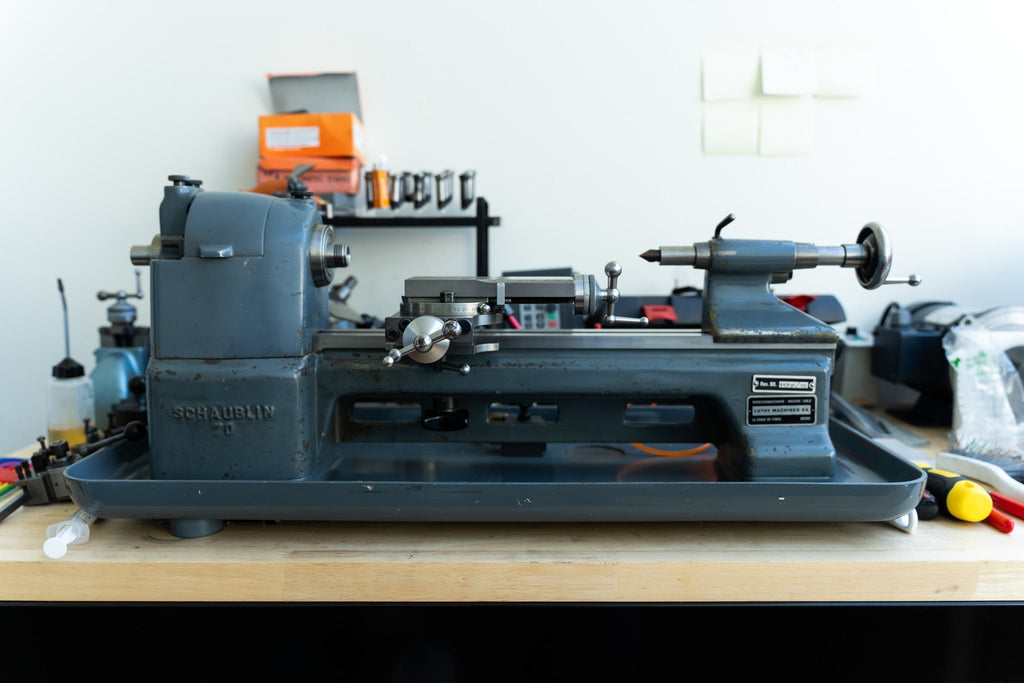From the Bench: Our “New” Lathe

Meet our (not so) new lathe, the Schaublin 70.
While new to us, this isn’t a “new” machine by any stretch—but that’s not a problem with precision machinery like this. The Schaublin 70 has been the backbone of manual machining in the watch industry for nearly a century, with its heritage stretching back to the 1930s, and is still produced today in the Jura mountains of Switzerland.
Schaublin lathes are delightfully accurate and robust, with the rare benefit of being able to handle “big” jobs while remaining accurate enough to machine tiny watch components. While there’s no shortage of large lathes, especially in the upper midwest, few can match Schaublins for accuracy.
We bought this lathe during our trip to Switzerland in December 2022 and brought it home in 4 extremely heavy suitcases. Yes, it’s possible to break down a Schaublin 70 and transport it in rolling luggage. No, my lower back does not recommend doing so.

Anticipation was high as we prepared to acquire the Schaublin. We spent weeks scouring the internet looking for a good quality lathe at the right price. We finally found our beloved Schaublin 70 for sale in a village not too far from Biel/Bienne, where our Swiss production partners are located. As fate would have it, the guy selling the machine happened to be an acquaintance of the Panerai instructor at my first job out of watchmaking school!
Though we were elated to have finally found a lathe that looked like it would be perfect for our workshop, anxiety was beginning to set in about the logistics of picking up the lathe as well as the Herculean task of transporting it all the way from Switzerland back to Chicago.
Here I am nervously looking at the mountainside preparing to pick up our rental car and begin our journey.

Once we made it to our destination, we set about inspecting the lathe.


We were then faced with the prospect of getting the parts into our hotel room.
You can imagine the looks we got as we used a luggage cart to haul all those carefully packed, heavy parts through our 4-star establishment. We were met with glares of suspicion as we wheeled everything into our hotel's tiny elevator, but the hard part was over.

We managed to get the lathe into our room safe and sound. We could relax for a bit until it was time to think about lugging this thing to the airport to transport it to its final destination.
The lathe's final journey presented its own challenges. We had to make sure this baby arrived in Chicago unscathed so we carefully packed up the parts using materials hastily purchased from a nearby home repair store.

So what exactly is this machine that we through so much trouble to get?
The Schaublin 70 gets its name from its “center height,” that is, the distance between the top of the lathe bed to the middle of the spindle—in this case, 70 mm. My Derbyshire Elect lathe, previously used in the workshop, has a spindle height of 60 mm. While 10 mm doesn’t sound like much, the 70 is also significantly more robust and massive, and that makes a huge difference.
Comparing the castings of the two lathes tells the whole story. The Schaublin is about 4 times as massive in all dimensions, which adds incredible amounts of rigidity to the setup. The parts are all made of cast iron as well, which has a strong vibration-dampening effect, increasing rigidity even further.

Rigidity is nothing without accuracy, and the Schaublin aces that test as well. Measured runout (eccentricity) of the main spindle is just a few microns, even tighter than the Derbyshire and fine enough for the smallest watch components.

Tooling availability is a huge benefit of the Schaublin as well. While Derbyshire made a wide variety of toolings and attachments for the Elect lathe, Schaublin 70s still have tooling made today, so it’s far easier to find and buy. We’ll discuss the importance of tooling in a different post, but keep this in mind: without tooling, a lathe is just a fancy way to make things turn in circles.

Nothing turns without power, though, and that’s been a challenge with this lathe as well. Typical US wall voltages are single-phase 120V AC, but this lathe takes three-phase 380V AC, an international voltage standard that’s relatively uncommon here. Most US 3-phase systems use 240V/480V, so a bit of creative conversion was in order. Suffice it to say that we got the proper voltage to the motor without doing anything dangerous or against code—it just required deeper research than usual to find a solution.

Stay tuned for more projects from this awesome machine. With a Schaublin 70 in the shop, almost anything is possible!

